Carpenter Ant Control
Signs of Infestation
The only external indication of infestation other than the presence of workers and/or swarmers (winged queens and males) is the appearance of small openings or windows on the surface of wood. Workers expel “frass” (small debris that accrues during tunnel excavation) out through these holes. Carpenter ant frass consists of sawdust-like shavings, fragments of insulation, and insect body parts. If you notice frass, especially below small holes in wood, then you probably have a carpenter ant infestation.
Inside, carpenter ant galleries follow the softer spring wood with numerous connections through the harder/dark summer wood. The gallery walls are smooth, with a sand-papered appearance. Workers move frass out of their active galleries. Carpenter ants prefer to attack wood softened by moisture and fungal rot. They are often associated with long-term moisture problems in structures.
Contact Plunkett's today for a FREE estimate!
Appearance And Behavior
There are three main varieties of carpenter ants depending on the species. These ants may be totally black, combinations of red, orange, yellow and black, or completely red or brown. All carpenter ants do not have a stinger. Larger species can inflict a painful pinch using their mandibles (jaws). Workers are capable of emitting a strong formic acid odor.
Most carpenter ant species establish their first nest in decayed wood and later expand into undamaged wood, insulation, or wall voids. Indoors, nests may be located in wood, insulation, and wall voids. You may hear carpenter ant nests rustling around inside wall voids or the wood where the colony is located. If you notice swarmers (flying reproductive ants) indoors, then carpenter ants have most likely established a colony in your home.
Carpenter ants feed primarily on insect honeydew, plant and fruit juices, insects, and arthropods. Inside, they will also feed on sweets, eggs, meats, cakes, and grease. The workers can wander up to 300 feet from the nest while foraging for food.
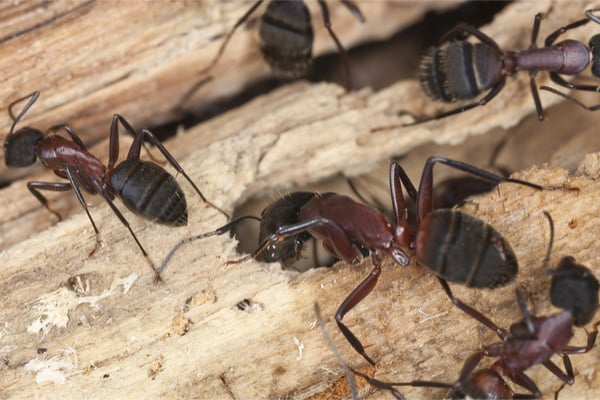
Carpenter ants get their name from their habit of hollowing out galleries in pieces of wood for nesting purposes. This nesting habit may result in structural damage. Fifty species of carpenter ants are found in the United States and Canada, 26 of which nest in structures.
BLACK CARPENTER ANTS
Camponotus pennsylvanicus, or Black carpenter ants, have workers that measure 1/4-1/2 inches long. They are completely black except for fine pale yellow “hairs” on top of their abdomen. The queens can reach 3/4 inch in length. This species is common in both rural and urban settings. It’s responsible for most of the carpenter ant-related damage inflicted on structures.
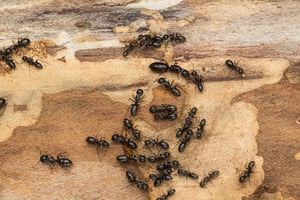
RUST-COLORED CARPENTER ANTS
Camponotus chromaiodes, or rust-colored carpenter ants, have workers that measure 1/4 to 1/2" long. Their head and abdomen are mostly black and the thorax and legs are mostly reddish. Queens measure 5/8 to 3/4" long. This species occurs more commonly in rural settings and wooded areas.
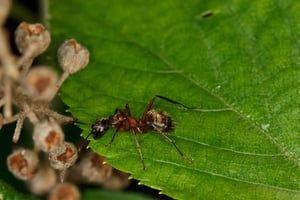
NEARCTIC CARPENTER ANTS
Camponotus nearcticus, or nearctic carpenter ants, have workers that measure 1/8 to 3/16" long. They can be completely glossy black or mostly black with a red thorax and legs. The queens can reach up to 5/16" long. This small species is common in both rural and urban settings. Nearctic carpenter ants don’t inflict the same scale of structural damage as black and rust-colored carpenter ants.
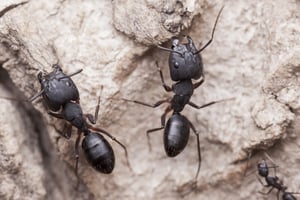
Carpenter Ant Prevention
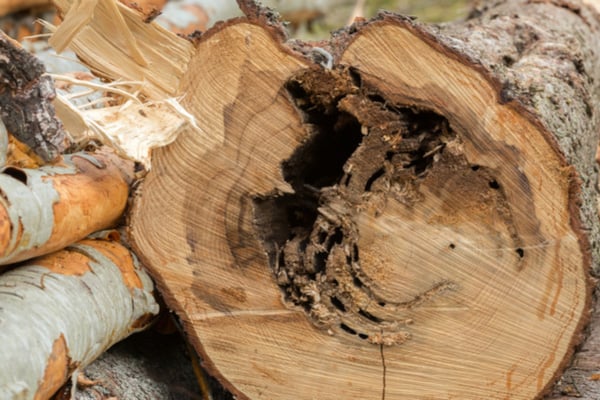
Inspection is the key to successful carpenter ant control. When you find worker ants indoors, the first place you should look for signs of infestation is the structure’s exterior. Keep an eye out for:
- Trailing ants on the foundation
- Bits of foam board insulation
- Trailing ants on all wires, utility lines and pipes coming into the walls
- Trailing ants on tree and shrub branches in contact with the wall
- Signs of excessive moisture such as peeling paint on wood thresholds, soffits, window frames, trim, and molding
Carpenter ants that are foraging from the outside can be kept out by filling obvious cracks and crevices using silicone sealer, builder’s putty, or mortar patch. Tree and shrub branches should be trimmed away from the roof and walls to prevent bridging contact points. In the yard, you should regularly inspect logs, stumps, firewood, tree cavities, dead tree limbs, and loose bark for ant nests.
Our Ant Control Process
When we treat carpenter ant infestations, we follow a step-by-step process:
- First, we check around your building’s perimeter for foraging trails, especially in the direction of trees and shrubs.
- Next, we locate indoor nests. To do that, we look for frass and listen for the ants using listening devices. We may use a sounding tool to gently tap suspect wood in order to elicit sounds to reveal the presence of nest cavities. Carpenter ants may form network of trails they follow throughout a structure. They often use edge lines, the tops of electrical wires, and water pipes. We’ll examine these features.
- Finally, we determine if the inside colony is a parent or satellite colony. We do this by observing carpenter ant activity. If we find a carpenter ant trail, we will follow it to the parent colony. If we find colony or colonies, we treat them directly using appropriately-labeled residual and non-residual insecticides.
However large or entrenched your carpenter ant infestation, we have what it takes to remove it once and for all.
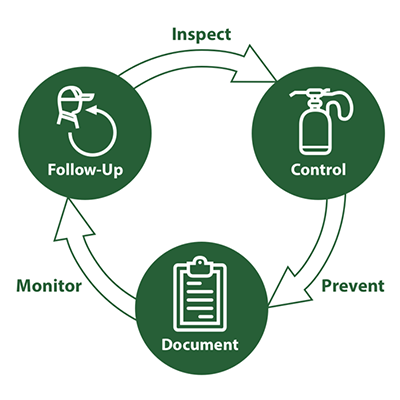
Ant Control With Plunkett's
At Plunkett’s, our goal is to help you quickly, conveniently, and in the most cost-effective way. We make every effort to be with you asap, usually within a day or two.
Learn More
There are several common varieties of ants that are particularly likely to make pests of themselves around your home. Some of the most common examples of indoor pest ants Plunkett’s encounters frequently include:






